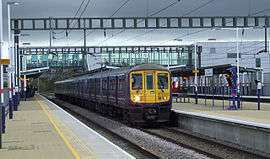Luton Airport
| London Luton Airport | |||||||||||
|---|---|---|---|---|---|---|---|---|---|---|---|
 | |||||||||||
 | |||||||||||
| Summary | |||||||||||
| Airport type | Public | ||||||||||
| Owner | Luton Borough Council[1] | ||||||||||
| Operator |
London Luton Airport Operations Ltd (Aena 51%; Ardian 49%)[2] | ||||||||||
| Serves | London, United Kingdom | ||||||||||
| Location | Luton, Bedfordshire, United Kingdom | ||||||||||
| Focus city for | |||||||||||
| Elevation AMSL | 526 ft / 160 m | ||||||||||
| Coordinates | 51°52′29″N 000°22′06″W / 51.87472°N 0.36833°WCoordinates: 51°52′29″N 000°22′06″W / 51.87472°N 0.36833°W | ||||||||||
| Website | london-luton.co.uk | ||||||||||
| Map | |||||||||||
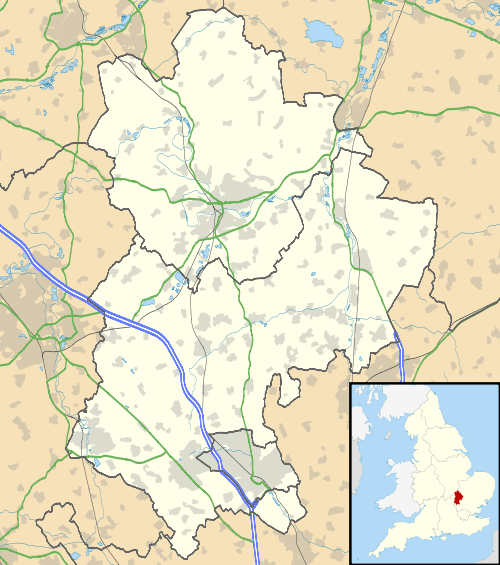 EGGW Location in Bedfordshire | |||||||||||
| Runways | |||||||||||
| |||||||||||
| Statistics (2017) | |||||||||||
| |||||||||||
|
"2010 to 2017 Statistics". London Luton Airport.
| |||||||||||
London Luton Airport (IATA: LTN, ICAO: EGGW), previously called Luton International Airport,[3] is an international airport located 1.5 nautical miles (2.8 km; 1.7 mi) east[4] of the town centre in the Borough of Luton in Bedfordshire, England, and is 25.2 NM (46.7 km; 29.0 mi) north[4] of Central London.
In 2016, over 14.6 million passengers passed through the airport, a record total for Luton making it the fifth busiest airport in the UK.[5] It is the fourth-largest airport serving the London area after Heathrow, Gatwick and Stansted, and is one of London's six international airports along with London City and Southend. The airport serves as a base for EasyJet, TUI Airways, Ryanair and Wizz Air and previously served as a base for Monarch Airlines until it ceased operations in October 2017. The vast majority of the routes served are within Europe, although there are some charter and scheduled routes to destinations in Northern Africa and Asia.
The airport is two miles from Junction 10 of the M1 motorway. Aside from Heathrow, London Luton Airport has the fastest rail connection from Central London at 22 minutes from St Pancras station, via East Midlands Trains, however passengers are transported to the terminal by shuttle-bus from Luton Airport Parkway railway station.
History
Early history
An airport was opened on the site on 16 July 1938 by the Secretary of State for Air, Kingsley Wood.[3] During World War II, it was a base for Royal Air Force fighters. Situated where the valley of the River Lea cuts its way through the north-east end of the Chiltern Hills, the airport occupies a hill-top location, with a roughly 40 m (130 ft) drop-off at the western end of the runway[6][7][8]
Following World War II, the land was returned to the local council which continued activity at the airport as a commercial operation. Percival Aircraft had its factory at the airport until the early 1960s.
From the mid-1960s, executive aircraft have been based at the airport, initially operated by McAlpine Aviation. These activities have grown and several executive jet operators and maintenance companies are now based at the airport, handling aircraft from all over the world.
It became the operating base for charter airlines such as Autair (which went on to become Court Line), Euravia (now TUI Airways, following Euravia's change of name to Britannia Airways and subsequent merger with First Choice Airways and TUI rebrand) and Dan-Air. In 1972, Luton Airport was the most profitable airport in the country. It suffered a severe setback in August 1974 when major package holiday operator Clarksons and its in-house airline Court Line (which also operated coach links) were liquidated.[3]
1980s and 1990s


In the 1980s the airport was seeing a decline in customer numbers; this was due to lack of reinvestment and Stansted Airport, also north of London, growing. The council responded to lobbying and focused again on developing the airport, first by operating the airport at arms length via an independent management team. As a result, necessary infrastructure work was undertaken. The next 15 years saw a process of updating, including the opening of a new international terminal, an automated baggage handling facility, a new control tower with updated air traffic control systems, a new cargo centre and runway upgrades.
The original runways had been grass tracks 18/36 and 06/24, and then a concrete runway 08/26. By the end of the 80s, there was only one runway, 08/26. The 18/36 grass runway had disappeared under a landfill, while 06/24 had effectively become a taxiway. To remain a viable airport it was necessary to update airfield services, and achieve CAT3 status. This meant updating ILS; glidepath and localiser and removing the hump in the runway; even a six-foot person could not see one end of the runway from the other. The hump was removed by building up layers at the end of the runway; this was done over 72 successive nights between October 1988 and February 1989, with the height being raised 90 mm on one particular night. During the course of this work, the airport would re-open for flights during the day.
While developing the basic infrastructure, various business partners were courted and business models were considered. The process envisaged a cargo centre, an airport railway station, and people mover from station to airport terminal (hence the unused underpass parallel to the road as you approach the terminal).
In 1990, the airport was renamed London Luton Airport to re-emphasise the airport's proximity to the UK capital. In 1991, another setback occurred when Ryanair, which had flown from the airport to Ireland for a number of years, transferred its London operating base to Stansted. Later in the 1990s, MyTravel Group began charter flights from the airport, using the Airtours brand and new low-cost scheduled flights from Debonair and EasyJet, the latter making Luton its base.[3]
In August 1997, to fund an £80 million extension of the airport, the council issued a 30-year concession contract to a public-private partnership consortium, London Luton Airport Operations Limited, a partnership of Airport Group International (AGI) and Barclays Private Equity. AGI was a specialist airport management and development company once owned by Lockheed Martin. In 1999 AGI was sold to TBI plc and in 2001 Barclays also sold its shares in Luton to TBI plc.[3]
The main feature of the development phase in 1998 was a £40 million terminal made from aluminium and glass, based on an original design by Foster + Partners. The new terminal, which was officially opened in November 1999 by Queen Elizabeth II and Prince Philip, houses 60 check-in desks, baggage and flight information systems and a wide range of shops, restaurants and bars.[3]
Development since the 2000s

In September 2004, a 9,000 sq ft (800 m2) area featuring a spectacular vaulted ceiling was completed with the new terminal, but intended to lie unused until required. On 1 July 2005, the new departure hall opened on schedule, featuring a boarding pier extending 200 m (660 ft) out between the airport's north and east aprons and relocated security, customs and immigration facilities. This also expanded the number of boarding gates from the previous number of 19 to current 26.
In 2004 the airport management announced[9] that they supported the government plans to expand the facilities to include a full-length runway and a new terminal.[10] However, local campaign groups, including Luton and District Association for the Control of Aircraft Noise (LADACAN)[11] and Stop Luton Airport Plan (SLAP)[12] opposed the new expansion plans, for reasons including noise pollution and traffic concerns; LADACAN also claimed that various sites, including Someries Castle, a Scheduled Monument, would be threatened by the expansion. On 6 July 2007, it was announced that the owners of London Luton Airport had decided to scrap plans to build a second runway and new terminal for financial reasons.[13] In order for the airport to expand further, the Department for Transport (DfT) advised the airport authority to use the airport site more efficiently. The DfT supports plans to extend the runway from its current 2,160 m (7,087 ft) length to 3,000 m (9,843 ft) and increase the length of the taxiway. A full-length runway would increase airlines' operational flexibility by enabling the use of aircraft that have a greater payload capacity and longer range than is currently possible. A longer taxiway would maximise runway use by reducing the need for taxiing aircraft to cross or move along the runway.
In January 2005, London Luton Airport Operations Limited was acquired by Airport Concessions Development Limited, a company owned by Abertis Infraestructuras (90%) and Aena Internacional (10%), both Spanish companies. control organisation.[3] In November 2013 ownership of London Luton Airport Operations Ltd passed to Aena and Ardian.[2]
From 2006 to 2008 Silverjet operated long-haul flights to Newark and Dubai from a dedicated terminal, but ceased operations due to the global economic crisis.
In September 2016, La Compagnie announced it would cease operating its Luton to Newark service citing economic reasons.[14] Therefore, Luton lost its only long-haul service.
In February 2017, Hungarian low-cost carrier Wizz Air announced to open its first British base at Luton Airport inaugurating three new routes to Tel Aviv, Pristina and Kutaisi[15] in addition to more than a dozen already served ones from other bases.
Facilities
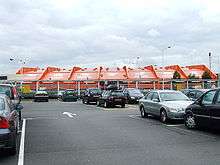
The airport possesses a single runway, running roughly east to west (08/26), with a length of 2,160 m (7,087 ft)[4] at an elevation of 526 ft (160 m). The runway is equipped with an Instrument Landing System (ILS) rated to Category IIIB, allowing the airport to continue operating in conditions of poor visibility.[16][17] All the airport facilities lie to the north of the runway. The terminal and aprons have a somewhat unusual layout, with ground-side access to the terminal being via a road (which goes under the taxiway) to a bus station, drop off area, taxi rank and short term car park on the runway side of the terminal building. There are approximately 60 stands available for aircraft. All of these stands are located on the northern side of the terminal building, away from the runway and connected to it by a 'U' shaped set of taxiways and aprons that together encircle the terminal.[6][7]
The northern side of the U-shaped apron is ringed by a continuous line of hangars and other buildings, emphasising the fact that Luton is a major maintenance base for several airlines including TUI Airways, EasyJet, and previously Monarch Airlines. By contrast to the heavily built up apron area, the airport's southern boundary is entirely rural with only a few isolated farm buildings and houses close to the airport boundary.[6][7]
The airport remains in municipal ownership, owned by Luton Borough Council but managed by the private sector London Luton Airport Operations Limited (LLAOL). London Luton Airport has a Civil Aviation Authority Public Use Aerodrome Licence (Number P835) that allows flights for the public transport of passengers or for flying instruction. An indicator of the importance of the airport to the economy of Luton is that Luton is reported to have the highest number of taxicabs per head of population in the United Kingdom.[18]
EasyJet's head office is Hangar 89 (H89), a building located on the grounds of London Luton Airport; the hangar, a former Britannia Airways/TUI facility, is located 150 metres (490 ft) from the former site of EasyLand, the previous headquarters of EasyJet. Hangar 89, built in 1974, has 30,000 sq ft (2,800 m2) of office space and can house two aircraft the size of an Airbus A320 or Boeing 737 at one time. When EasyJet received H89, it had a 1970s style office setup. EasyJet modernised the building and painted it orange.[19]
In addition, TUI Airways has their head offices located at the airport, and prior to their closure Monarch Airlines's head office, along with that of Monarch Group, was in Prospect House, on the grounds of the airport.[20][21]
Terminal
Luton Airport features one single, two-storey passenger terminal building which has been expanded and rearranged several times. The ground floor features a main hall equipped with 62 check-in desks (1-62), a separate security screening hall, as well as some shops, service counters and the arrivals facilities.[22] After the security screening hall, stairs lead to the departures lounge on the upper floor, where several more stores, restaurants and all 28 departure gates in two side piers (1-19 and 20-28) can be found.[22] Besides branches of Burger King, Starbucks, Boots and others, one airport lounge is located inside the terminal.[22]
Airlines and destinations
Passenger
The following airlines operate regular scheduled and charter flights to and from Luton:[23]
Cargo
Statistics
Traffic development
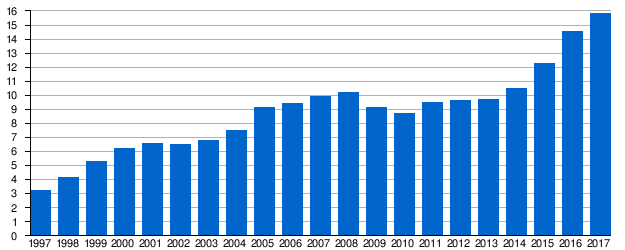 |
| Updated: 19 March 2018. |
| Number of Passengers[nb 1] | Number of Movements[nb 2] | Freight (tonnes)[nb 3] | |
|---|---|---|---|
| 1997 | 3,238,458 | 63,586 | 21,354 |
| 1998 | 4,132,818 | 70,667 | 25,654 |
| 1999 | 5,284,810 | 79,423 | 23,224 |
| 2000 | 6,190,499 | 84,745 | 32,992 |
| 2001 | 6,555,155 | 83,707 | 23,070 |
| 2002 | 6,486,770 | 80,924 | 20,459 |
| 2003 | 6,797,175 | 85,302 | 22,850 |
| 2004 | 7,535,614 | 94,379 | 26,161 |
| 2005 | 9,147,776 | 107,892 | 23,108 |
| 2006 | 9,425,908 | 116,131 | 17,993 |
| 2007 | 9,927,321 | 120,238 | 38,095 |
| 2008 | 10,180,734 | 117,859 | 40,518 |
| 2009 | 9,120,546 | 98,736 | 28,643 |
| 2010 | 8,738,717 | 94,575 | 28,743 |
| 2011 | 9,513,704 | 97,574 | 27,905 |
| 2012 | 9,617,697 | 96,797 | 29,635 |
| 2013 | 9,697,944 | 95,763 | 29,074 |
| 2014 | 10,484,938 | 101,950 | 27,414 |
| 2015 | 12,279,176 | 116,412 | 28,041 |
| 2016 | 14,551,774 | 131,536 | 25,464 |
| 2017 | 15,799,219 | 135,538 | 21,199 |
Busiest routes
| Rank | Airport | Total passengers | Change 2015 / 16 |
|---|---|---|---|
| 1 | Copenhagen | 767,732 | |
| 2 | Amsterdam | 608,188 | |
| 3 | Budapest | 572,472 | |
| 4 | Bucharest | 513,647 | |
| 5 | Warsaw–Chopin | 400,944 | |
| 6 | Tel Aviv–Ben Gurion | 370,135 | |
| 7 | Barcelona | 367,189 | |
| 8 | Dublin | 349,852 | |
| 9 | Katowice | 314,117 | |
| 10 | Belfast–International | 310,431 | |
| 11 | Málaga | 304,038 | |
| 12 | Vilnius | 297,840 | |
| 13 | Palma de Mallorca | 284,387 | |
| 14 | Sofia | 279,840 | |
| 15 | Edinburgh | 272,503 | |
| 16 | Geneva | 268,760 | |
| 17 | Gdańsk | 268,657 | |
| 18 | Faro | 255,398 | |
| 19 | Paris–Charles de Gaulle | 254,009 | |
| 20 | Cluj–Napoca | 240,485 |
Ground transport
Road
The airport lies a few miles away from the M1 motorway, which runs southwards to London, northwards to Leeds and connects to the M25 motorway. There is a short stay car park adjacent to the terminal, together with medium and long term on airport car parks to the west and east of the terminal respectively and linked to the terminal by shuttle buses. Pre-booked off airport parking is also available from several independent operators.
Rail
Luton Airport Parkway was built in 1999 to serve the airport. It is located on the Midland Main Line from London St Pancras and can be reached from London St Pancras in as little as 22 minutes via East Midlands Trains.
Thameslink is the primary operator, with services running from the station to Bedford, St Albans, London, Wimbledon, Sutton, Gatwick Airport and Brighton.
East Midlands Trains operate semi-fast services calling at Parkway station hourly. These trains run south directly to London St Pancras and north to Bedford, Wellingborough, Kettering, Corby, Market Harborough, Leicester, Loughborough, Beeston and Nottingham.
A shuttle bus service connects the railway station to the airport, a distance of just over a mile. The fare is included in rail tickets to Luton Airport or a cash fee is charged for non ticket holders.
Several schemes have been proposed to replace the shuttle bus with some form of rail link. In 2007, a proposal to replace the shuttle buses with a segregated tracked transit system was announced.[41] Ambitious plans to build a new direct railway link from the Midland Main Line to the airport were put forward in 2015, with the aim of reducing the journey time from central London to the airport to 20min and significantly increasing passenger numbers.[42] In 2016 plans by airport owners LLAL (Luton BC) were announced to build the Luton DART, a 1.4-mile (2.3 km) light rail link from the Parkway station to the airport at a cost of £200 million. A planning application was submitted in Autumn 2016; it was accepted in June 2017. The link will come into passenger service by the end of 2020.[43][44]
In 2016 the airport operators received the backing of the CBI, easyJet, the Federation of Small Businesses (FSB), Bedfordshire Chamber of Commerce and Hertfordshire Chamber of Commerce (among others) for their campaign for better rail links to Luton Airport Parkway. They are calling on the government to make it a requirement of the new East Midlands franchise holder to introduce four fast trains per hour from central London.[45]
Negotiations are currently underway with the Department for Transport to extend the validity of the London Oyster card contactless ticketing system to Luton Airport Parkway and it is planned that Oyster will be valid for travel on Thameslink services to the airport by 2018.[44]
Buses
.jpg)
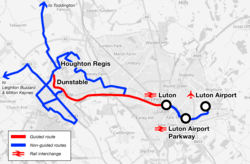
Local buses connect Luton Airport with Luton town centre and other nearby places.
The airport is the served by the Route A of the Luton to Dunstable Busway, a bus rapid transit route which connects the airport with Luton Town Centre and the neighbouring towns of Dunstable, Houghton Regis and Milton Keynes. The buses, operated by Arriva Shires & Essex, run on a segregated guided busway track across Luton.[46]
Conventional bus services also operate, connecting the airport with towns and cities in the region and parts of north London, including the 100, operated by Arriva, which offers an hourly daytime connection to the nearby towns of Hitchin and Stevenage; Metroline service 84A; Courtney Buses coach service to Bracknell.[47]
Direct coach services to London include Green Line route 757 operated by Arriva Shires & Essex and the A1 operated by National Express which operate competing services to and from Victoria Coach Station. EasyBus services operate towards Liverpool Street station. A range of longer distance National Express services linking Stansted, Heathrow and Gatwick Airports as well as destinations in the Midlands and North of England.[47]
Govia Thameslink Railway provide a shuttle bus link between the airport and Luton Airport Parkway railway station. This service runs 24 hours a day - every 10 minutes from 5am to 12am and between 12am to 5am it is timed to meet each overnight train service.[47]
There are also three services around the airport operated by APCOA Parking which operate 24 hours serving the terminal and Mid Term, Long term, and Staff Car parks the service that serves the staff car park also serves the car hire centre and rental companies and all stops in between including the Holiday Inn express, the TUI Airways HQ And the ID Unit. A new fleet of six Mercedes-Benz Citaro buses were purchased for these operations during 2014.
A range of other bus services operated by off-site parking companies also serve the airport. These include Airparks, Paige Airport Parking, Centrebus and Coach Hire 4 U. The latter two operators provide staff shuttle buses on behalf of TUI and EasyJet.
In the media
- London Luton Airport is widely known as a result of the Airline and Luton Airport television series. Airline follows the staff of EasyJet at Luton and the airline's other bases across the country whilst the 2005 series, named after the airport, followed the life of employees in a similar format to the show Airport which follows staff at Heathrow Airport.
- The airport was also mentioned in a famous Campari advert featuring Lorraine Chase, with the punch line "Were you truly wafted here from paradise?". " Nah, Lut'n Airport". This advert was the inspiration for the 1979 UK hit song "Luton Airport" by Cats UK.
- Luton Airport was also mentioned in the Piranha Brothers sketch from Monty Python's Flying Circus, as being the place where one of the brothers, Dinsdale, thinks that a giant hedgehog named Spiny Norman sleeps.
- In 2011 the airport featured in an episode of the series Supersize Grime which focused on the cleaning of an Airbus A321 at the Monarch Aircraft Engineering hangar 127.
Accidents and incidents
- 4 November 1949: A Hawker Tempest single-engined piston fighter being operated by Napier Aircraft on a test flight crashed at the airport killing the test pilot.[48]
- 23 December 1967: A Hawker Siddeley HS 125 (registration: G-AVGW) of Court Line crashed shortly after taking off from Luton Airport, killing both pilots. The aircraft had been on a training flight. The crash occurred when the crew simulated an engine failure on takeoff. The HS 125 lost height rapidly and hit the roof of a nearby factory. This resulted in a post-crash fire.[49]
- 3 March 1974: A Douglas DC-7C/F (registration: EI-AWG) operating an Aer Turas Teo charter flight from Dublin landed on runway 08 just after midnight but failed to achieve reverse thrust. Normal braking application also appeared to the crew to be ineffective and the emergency pneumatic brakes were applied. All main wheel tyres burst. The aircraft overran the runway and continued over the steep bank at the eastern perimeter finally coming to rest in soft ground 90 metres beyond. The situation had also been made worse by an inadvertent application of forward thrust by the crew in trying to achieve reverse thrust. Three of the six passengers and two of the four crew were injured. The aircraft was badly damaged and deemed a write-off.[50][51]
- 18 April 1974: A BAC One-Eleven 518FG (registration: G-AXMJ) operating Court Line Flight 95 was involved in a ground collision with Piper PA-23 Aztec (registration: G-AYDE) after the Aztec entered the active runway without clearance. The pilot of the Aztec was killed and his passenger was injured. All 91 people on board the One-Eleven successfully evacuated after take-off was aborted.
- 21 June 1974: A Boeing 727-46 (registration: G-BAEF) operating a Dan-Air charter flight to Corfu hit the localiser antenna while taking off, thereby rendering the runway's ILS inoperative. After being told by Luton air traffic control about the incident, the crew flying the aircraft elected to divert to London Gatwick where it landed safely without harming its 134 occupants (eight crew members and 126 passengers).[52] The subsequent investigation revealed that the aircraft only just became airborne at the end of the runway, and as the ground fell away to the Lea valley below, the aircraft actually followed a downsloping course until finally gaining positive climb. The report concluded that there had been a cumulative effect of three factors — erosion of take-off run available; delay in starting rotation; and a very slow rate of rotation — as a result of the flightdeck crew's miscalculation of the aircraft's takeoff weight (too high), a wrong pressure ratio for two of the aircraft's three engines (too low) and a sub-optimal choice of runway based on the use of outdated wind information that omitted the latest update's tailwind component.[51][53]
- 29 March 1981: A Lockheed JetStar 1329 (registration: N267L) operating an inbound flight from Nigeria overran runway 08 and came to rest down the embankment beyond the eastern perimeter fence. The accident was caused because the pilot landed well past the touchdown zone in poor visibility at night. At the time runway 08 did not have an ILS. The co-pilot suffered severe spinal injuries but the commanding pilot and seven passengers escaped with only minor injuries.[54]
- 15 January 1994: A Bell 206B JetRanger helicopter (registration: G-BODW) rolled over on take off. One of the rotor blades sliced into the cabin, killing the pilot. The aircraft was badly damaged and deemed a write-off.[55]
Notes and references
Notes
Citations
- ↑ "London Luton Airport Limited - About us". www.llal.org.uk.
- 1 2 "Ardian and Aena complete acquisition of London Luton Airport - Airport Technology". 28 November 2013.
- 1 2 3 4 5 6 7 "Airport History". London Luton Airport. Retrieved 16 July 2007.
- 1 2 3 "London Luton – EGGW". Nats-uk.ead-it.com. Retrieved 21 April 2011.
- ↑ "Aircraft and passenger traffic data from UK airports". UK Civil Aviation Authority. 3 March 2017. Retrieved 14 March 2017.
- 1 2 3 Ordnance Survey (2006). OS Explorer Map 182 – St Albans & Hatfield. ISBN 978-0-319-23780-9.
- 1 2 3 Ordnance Survey (2006). OS Explorer Map 193 – Luton & Stevenage. ISBN 978-0-319-23783-0.
- ↑ "Ordnance Survey". Getamap.ordnancesurvey.co.uk. Retrieved 21 April 2011.
- ↑ "London Luton Airport – Future Developments". London-luton.co.uk. Archived from the original on 14 May 2011. Retrieved 21 April 2011.
- ↑ Luton and District Association for the Control of Aircraft Noise – Communities affected Archived 3 April 2005 at the Wayback Machine.
- ↑ "Luton and District Association for the Control of Aircraft Noise – Campaign Headlines". Ladacan.org. 22 January 2011. Retrieved 21 April 2011.
- ↑ Stop Luton Airport Plan Archived 8 May 2006 at the Wayback Machine.
- ↑ "New runway plans at Luton shelved". BBC News. 6 July 2007. Retrieved 21 April 2011.
- ↑ "Archived copy" (PDF). Archived from the original (PDF) on 6 September 2016. Retrieved 5 September 2016.
- ↑ standard.co.uk - Time to party as Wizz Air sets up Luton airport base 16 February 2017
- ↑ "Luton Airport Technical Data". TMC Ltd. Archived from the original on 3 January 2007. Retrieved 20 December 2006.
- ↑ "Community Newsletter – August 2006". London Luton Airport. Archived from the original on 4 June 2011. Retrieved 21 December 2006.
- ↑ "Luton South", UK Polling Report
- ↑ "New headquarters for easyJet at London Luton Airport". Easyjet. Archived from the original on 28 January 2010. Retrieved 28 January 2010.
- ↑ "Write to Us". Monarch Airlines. 5 March 2013. Archived from the original on 5 March 2013. Retrieved 2 October 2017.
Monarch Airlines Prospect House Prospect Way London Luton Airport Luton Bedfordshire LU2 9NU ENGLAND
- ↑ "Head and Divisional Offices". Monarch Group. 8 March 2013. Archived from the original on 8 March 2013. Retrieved 2 October 2017.
The Monarch Group and Monarch Airlines Prospect House Prospect Way London Luton Airport Luton Bedfordshire LU2 9NU UK
- 1 2 3 london-luton.co.uk - Map of Departures and Arrivals at LLA retrieved 8 October 2016
- ↑ london-luton.co.uk - FLIGHTS retrieved 9 September 2016
- 1 2 "easyJet schedules new routes from the UK in W18". Routesonline. Retrieved 2018-08-24.
- ↑ "Horarios de vuelos". Iberia. Retrieved 2018-08-24.
- 1 2 3 4 5 https://corporate.ryanair.com/news/ryanair-announces-200m-investment-in-london-luton-with-2-new-based-aircraft/
- ↑ "Cork to London Luton Airport Announced For Winter 2018". Cork Airport. 23 August 2018. Retrieved 24 August 2018.
- ↑ "Route network - SunExpress".
- 1 2 https://www.thomascookairlines.com/en/generated/timetable_S2019.pdf
- 1 2 3 4 5 6 7 "Flight Timetable". tui.co.uk. 5 November 2017. Retrieved 5 November 2017.
- ↑ https://www.routesonline.com/news/38/airlineroute/280278/tui-airways-uk-adds-new-short-haul-sectors-in-w18/
- 1 2 "Ski Holidays 2017/2018 - Get More Winter With Crystal Ski". Crystal Ski.
- ↑ "Official Wizz Air website". Wizzair.com. 2016-09-01. Retrieved 2018-08-24.
- ↑ Smith, Rebecca (20 November 2017). "Wizz Air has just announced big expansion plans for London". cityam.com.
- 1 2 "Timetable". Wizzair.com. 2016-09-01. Retrieved 2018-08-24.
- 1 2 3 4 "Wizz Air Announces Four New Winter Routes From London Luton". Wizzair.com. Retrieved 2018-08-24.
- ↑ Air France flight AF 7000: Charles De Gaulle, Paris - Ataturk, Istanbul via Luton, London
- ↑ Airlines, MNG. "MNG AIRLINES - SERVICES". www.mngairlines.com.
- ↑ "2010 to 2017 Statistics". London Luton Airport.
- ↑ "Airport Data 2016". UK Civil Aviation Authority. 3 March 2017. Tables 12.1(XLS) and 12.2 (XLS). Retrieved 16 March 2017.
- ↑ "Blue Skies Easing the Pressure". The Monitor. Retrieved 17 July 2007.
- ↑ "Luton Airport reveals plans for new direct rail service".
- ↑ "Luton Airport could get a new £200m 'Tube-style' link". Evening Standard. Archived from the original on 15 April 2016. Retrieved 15 April 2016.
- 1 2 Topham, Gwyn (15 April 2016). "Luton airport calls time on bus transfers with £200m fast-track to trains". The Guardian. Archived from the original on 15 April 2016. Retrieved 15 April 2016.
- ↑ "Maximising opportunities for the next East Midlands rail franchise". London-luton.co.uk. Retrieved 2018-08-24.
- ↑ "Luton and Dunstable guided busway 'good for economy'". BBC. 24 September 2013. Retrieved 18 February 2015.
- 1 2 3 "WHAT BRINGS YOU TO LONDON LUTON AIRPORT?". Luton Airport. Archived from the original on 22 November 2017. Retrieved 22 November 2017.
- ↑ "Test Pilot Killed". News in Brief. The Times (51531). London. 5 November 1949. col C, p. 4.
- ↑ "ASN Aircraft accident Hawker Siddeley HS-125-3B G-AVGW London–Luton Airport (LTN)". Aviation-safety.net. Retrieved 21 April 2011.
- ↑ "12/1975 Douglas DC 7C/F, E1-AWG, 3 March 1974 - GOV.UK".
- 1 2 "AIB reports on Luton incidents, Air Transport, Flight International, 13 November 1975, p. 714".
- ↑ "ASN Aircraft accident Boeing 727-46 G-BAEF London–Luton Airport (LTN)". Aviation-safety.net. Retrieved 21 April 2011.
- ↑ "Public transport accidents, World News, Flight International, 18 July 1974, p. 51".
- ↑ "ASN Aircraft accident Lockheed L-1329 JetStar 6 N267L London–Luton Airport (LTN)". Aviation-safety.net. Retrieved 21 April 2011.
- ↑ "AAIB accident report Bell 206B JetRanger G-BODW London–Luton Airport (LTN)". aaib.gov.uk. Missing or empty
|url=(help)
External links
![]()
